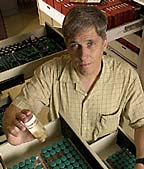Parasitology, Harold W. Manter Laboratory of

Scott L. Gardner Publications
Document Type
Article
Date of this Version
3-23-2020
Citation
Journal of Parasitology (2020) 106(2): 235–246
Abstract
Gaharitrema droneni n. gen., n. sp. (Digenea: Zoogonidae: Lepidophyllinae) is described from the intestine of the pudgy cuskeel, Spectrunculus grandis (Gu¨ nther, 1877) (Ophidiiformes: Ophidiidae), collected at 2,800 m depth from the northeastern Pacific Ocean off Oregon. The new genus is distinguished from Brachyenteron Manter, 1934 and Steganoderma Stafford, 1904, the 2 closest lepidophylline genera, and from 4 other zoogonid genera erected since 2007, the last major revision of the family, by a combination of diagnostic features including a pyriform or spindle-shaped body, smooth testes and ovary, narrow ceca that reach with the vitellarium into the hindbody, an unspecialized ventral sucker, non-filamented eggs, a claviform cirrus pouch, and an unpocketed ejaculatory duct and metraterm, and the new genus lacks circumoral spines. We present updated keys to the 3 subfamilies of the Zoogonidae Odhner, 1902, as well as to the genera of the Cephaloporinae Yamaguti, 1934 and the Lepidophyllinae Stossich, 1903. A listing of the parasites known from S. grandis also is presented. This study documents the third family of digeneans (Zoogonidae) known to parasitize S. grandis, and it is a new host record (i.e., the first zoogonid reported from this host species). We discuss the relatively impressive presence of the Zoogonidae and their hosts within the deep sea. Specifically, of the 35 genera we recognize within this digenean family, 14 (40%) have deep-sea representatives. At least 37 species within 27 genera and 19 families within 11 orders of deep-sea fish are known to harbor zoogonids. Furthermore, of the 37 known deep-sea fish species parasitized by zoogonids, only 5 (13.5%) harbor 2 or more zoogonid species; the remaining 32 (86.5%) harbor only 1 parasite species each, indicating strong host specificity. Finally, the dietary ecology of S. grandis is presented, allowing us to speculate that Gaharitrema droneni may be utilizing gastropods and polychaetes as well as S. grandis to complete its life cycle in the deep sea.
Included in
Biodiversity Commons, Biology Commons, Ecology and Evolutionary Biology Commons, Parasitology Commons, Zoology Commons


Comments
Copyright 2020, American Society of Parasitologists. Used by permission